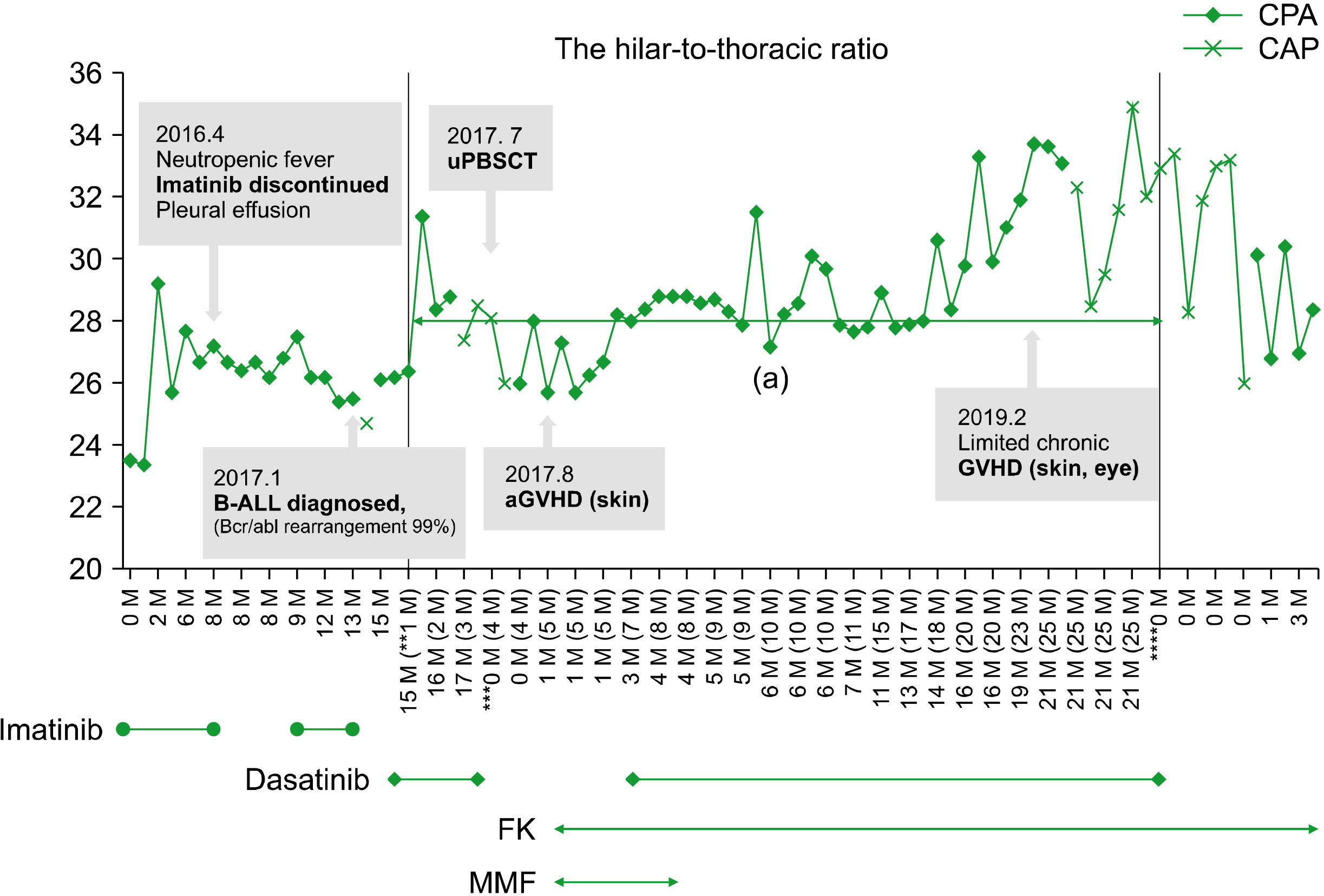Blood Res.
2022 Mar;57(1):80-84. 10.5045/br.2021.2021198.
Dasatinib-induced reversible pulmonary arterial hypertension in a pediatric patient with BCR/ABL1+ lymphoblastic lymphoma from chronic myeloid leukemia
- Affiliations
-
- 1Department of Pediatrics, Seoul National University College of Medicine, Seoul, Korea
- 2Seoul National University Cancer Research Institute, Seoul, Korea
- 3Wide River Institute of Immunology, Seoul National University, Seoul, Korea
- KMID: 2527502
- DOI: http://doi.org/10.5045/br.2021.2021198
Figure
Reference
-
1. Baccarani M, Cortes J, Pane F, et al. 2009; Chronic myeloid leukemia: an update of concepts and management recommendations of European LeukemiaNet. J Clin Oncol. 27:6041–51. DOI: 10.1200/JCO.2009.25.0779. PMID: 19884523. PMCID: PMC4979100.
Article2. McCafferty EH, Dhillon S, Deeks ED. 2018; Dasatinib: a review in pediatric chronic myeloid leukemia. Paediatr Drugs. 20:593–600. DOI: 10.1007/s40272-018-0319-8. PMID: 30465234.
Article3. Baccarani M, Deininger MW, Rosti G, et al. 2013; European LeukemiaNet recommendations for the management of chronic myeloid leukemia: 2013. Blood. 122:872–84. DOI: 10.1182/blood-2013-05-501569. PMID: 23803709. PMCID: PMC4915804.4. Montani D, Bergot E, Günther S, et al. 2012; Pulmonary arterial hypertension in patients treated by dasatinib. Circulation. 125:2128–37. DOI: 10.1161/CIRCULATIONAHA.111.079921. PMID: 22451584.
Article5. El-Dabh A, Acharya D. 2019; EXPRESS: pulmonary hypertension with dasatinib and other tyrosine kinase inhibitors. Pulm Circ. 9:2045894019865704. DOI: 10.1177/2045894019865704. PMID: 31274047. PMCID: PMC6664660. PMID: df5016ddf59f4a5abdca670e34588af5.6. Gore L, Kearns PR, de Martino ML, et al. 2018; Dasatinib in pediatric patients with chronic myeloid leukemia in chronic phase: results from a phase II trial. J Clin Oncol. 36:1330–8. DOI: 10.1200/JCO.2017.75.9597. PMID: 29498925. PMCID: PMC5929218.
Article7. Lee JW, Kang HJ, Kim S, et al. 2015; Favorable outcome of hematopoietic stem cell transplantation using a targeted once-daily intravenous busulfan-fludarabine-etoposide regimen in pediatric and infant acute lymphoblastic leukemia patients. Biol Blood Marrow Transplant. 21:190–5. DOI: 10.1016/j.bbmt.2014.09.013. PMID: 25255163.8. Shimada R, Takeshita A, Nakamura M. 1984; Noninvasive assessment of right ventricular systolic pressure in atrial septal defect: analysis of the end-systolic configuration of the ventricular septum by two-dimensional echocardiography. Am J Cardiol. 53:1117–23. DOI: 10.1016/0002-9149(84)90647-7. PMID: 6702690.
Article9. Altschul E, Remy-Jardin M, Machnicki S, et al. 2019; Imaging of pulmonary hypertension: pictorial essay. Chest. 156:211–27. DOI: 10.1016/j.chest.2019.04.003. PMID: 30981724.10. Lupi E, Dumont C, Tejada VM, Horwitz S, Galland F. 1975; A radiologic index of pulmonary arterial hypertension. Chest. 68:28–31. DOI: 10.1378/chest.68.1.28. PMID: 1149525.
Article11. Barst RJ, Ertel SI, Beghetti M, Ivy DD. 2011; Pulmonary arterial hypertension: a comparison between children and adults. Eur Respir J. 37:665–77. DOI: 10.1183/09031936.00056110. PMID: 21357924. PMCID: PMC3128436.
Article12. Haouala A, Widmer N, Duchosal MA, Montemurro M, Buclin T, Decosterd LA. 2011; Drug interactions with the tyrosine kinase inhibitors imatinib, dasatinib, and nilotinib. Blood. 117:e75–87. DOI: 10.1182/blood-2010-07-294330. PMID: 20810928.
Article
- Full Text Links
- Actions
-
Cited
- CITED
-
- Close
- Share
- Similar articles
-
- A narrative review on adverse effects of dasatinib with a focus on pharmacotherapy of dasatinib-induced pulmonary toxicities
- A Case of Acute Promyelocytic Leukemia with Co-existence of BCR-ABL1 and PML-RARA Rearrangements Detected by PCR
- Coexistence of BCR/ABL1-positive chronic myeloid leukemia and JAK2 V617F-mutated myelofibrosis successfully treated with dasatinib and ruxolitinib
- Reversible Pulmonary Arterial Hypertension Associated with Dasatinib for Chronic Myeloid Leukemia
- Genomic Profiling of Chronic Myelogenous Leukemia: Basic and Clinical Approach



